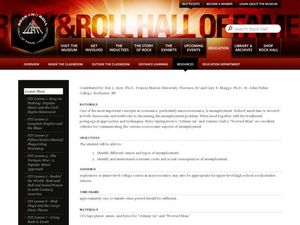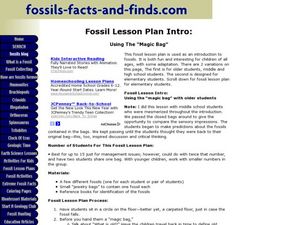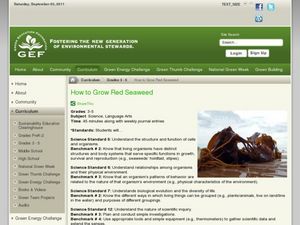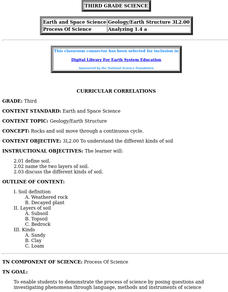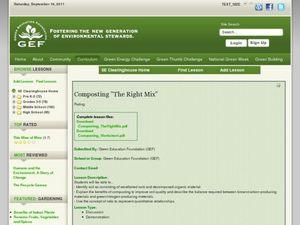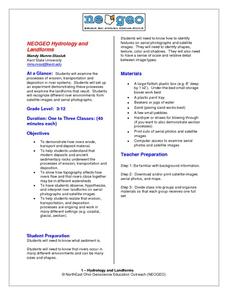Curated OER
Ancient Animals
Students explore ancient rock art in Arkansas. Through discussion, research, and hands on activities, they identify the animals and stylized features of rock art found in Arkansas. Students identify the various habitats of he animals...
Curated OER
Bridge Construction
Students build a model of a bridge and test the amount of weight it support. They identify different types of bridges: suspension, arch, girder, truss, cantilever, cable-stayed and moveable.
Curated OER
Mineral Identification
For this mineral identification worksheet, students match 10 terms to their definitions. Terms include types of minerals, tests and characteristics of minerals. They write down the tests used to identify an unknown mineral and they fill...
Curated OER
Teaching Economics and Rock and Roll: Unemployment
Students explore the consequences of unemployment. In this macroeconomics lesson, students listen to the songs “Johnny 99” and “Worried Man.” Students discuss the socioeconomic costs of unemployment as they analyze the songs.
Curated OER
Fossils
In this earth science learning exercise, learners use the clues given at the bottom of the sheet to solve the crossword puzzle on fossils. They identify specific names of fossils and how to make a mold of one.
Curated OER
The Earth's Interior
Eighth graders identify the layers of the Earth's interior, while learning to use WP utilities.
Curated OER
Screening River Rocks
First graders explore river rocks. Searching with screens and containers, 1st graders identify the different kinds and sizes of rocks. They separate rocks into containers according to pebbles, gravel and sand. Students write about their...
Curated OER
Fossil Facts and Finds- Using the Magic Bag
Students investigate fossils. In this geology instructional activity, students study various types of fossils in rocks and identify the characteristics of the fossil. Students write a research paper on their fossil.
Curated OER
Relative Age Dating
Modeling dough and paper cutouts in science class? Learn about how relative age dating concepts, like the Law of Superposition and cross-cutting relationships, can be used to describe the formation of sedimentary layers.
Kenan Fellows
Sustainability: Learning for a Lifetime – Soil
Do great gardeners really have green thumbs—or just really great soil? Environmental scholars discover what makes Earth's soil and soil quality so important through research and experimentation. Learners also develop an understanding of...
Curated OER
Science: Fossil of a Carbonized Plant
Learners classify leaves by shape and margins and use them to create models of plant fossils. By using paper over a leaf, they simulate fossilization of organisms onto sedimentary rocks. Following instructions on worksheets, students...
Curated OER
The Geology of a Snicker’s Bar: Tectonic Plates
Pupils explore the layers of the Earth using a Snicker's bar. In this science instructional activity, students identify the parts of the Snicker's bar and identify which layer of the Earth the parts of the candy bar would represent....
Curated OER
How To Grow Red Seaweed
Learners explore ocean biology by participating in a plant growing activity. In this seaweed lesson, students identify the importance and uses of seaweed in the ocean and examine different seaweed samples. Learners utilize an aquarium,...
Curated OER
Curricular Correlations
An interesting lesson on different types of soils is here for you. In it, learners discuss what soil is, and consider three piles of soil - clay, sand, and loam. During the rest of the lesson, third graders discover all sorts of...
Curated OER
The Japanese Garden
High schoolers use the internet to gather information on the Japanese Gardens. They discuss topics with a horticulturist and build a replica of the gardens at their school. They work together to identify different types of plants.
Curated OER
Composting "The Right Mix"
Students investigate the correct mix of material types for compost. In this composting lesson, students explore the correct amounts of different types of materials to create a compost heap. Students then create a compost heap.
Curated OER
What Is An Insect?
Students find and classify insects. They collect insects, study them with a hand lens and identify its body parts. Afterwards, they discus various types of insects and thier Orders such as beetles, butterflies and moths, grasshoppers, etc.
Curated OER
Seepy Sandwich
Students explore Earth science by participating in a pollution activity. In this water infiltration lesson plan, students utilize a water sprayer, food coloring and slices of bread to simulate how pollution can spread into our drinking...
NorthEast Ohio Geoscience Education Outreach
Hydrology and Landforms
Three days of erosion exploration await your elementary geologists. Learners begin by examining rivers via Google Earth, then they model water flow in sand, and finally, they identify resulting landforms. This lesson is written...
Curated OER
Weathering, Erosion, and Deposition Study Guide
In this weathering, erosion and deposition worksheet, students answer questions about the causes of weathering, the types of weathering such as mechanical and chemical weathering and resistance to weathering. They also write two...
Curated OER
Mineral Magic
Students classify rocks and minerals according to their characteristics, after finding the similarities and differences of school supplies and pasta.
Curated OER
Caldecott Tunnel
Students visit the Caldecott Tunnel. They examine dark brown basalt and the gray-green sedimentary rocks and draw picture of the rock layers in the cliff face. In addition, they write a short paragraph describing what you observe about...
Curated OER
Minerals and the Products of Mining
Students plot where minerals come from and have an awareness of how mineral use makes the world interdependent. They examine how to identify some sort of mineral products they use each day.
Curated OER
Boombox Classroom: Ensembles
For this music worksheet, students identify types of ensembles. They order duet, quartet, solo, and trio by the number of performers in each. Students complete a word search, looking for ensemble related words.





